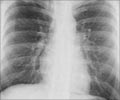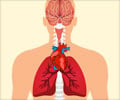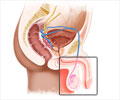New blood test that measures levels of expression of four genes is able to accurately predict the development of tuberculosis in high risk household contacts of active TB cases
Highlights:
- New blood test that measures levels of expression of combination of four-genes can predict development of tuberculosis two years before onset in contacts who are at high risk
- Currently there is no test that can predict development of TB without putting large numbers of people who are at low risk to undergo unnecessary preventive anti-tuberculous treatment.
Reason for Study
Although those living with someone having active TB infection are at greatest risk for developing the disease, only about 5-20 percent of people exposed to tuberculosis infection go on to develop active TB. Currently there is no test that can distinguish between low risk and high risk (of developing disease) contacts exposed to active TB infection.Levels of four-gene signature combination blood test identify persons at risk upto two years before onset of disease, overcoming the need for persons at low risk to go through preventive anti-tuberculous therapy with known side effects.
"We found that this prediction [up to two years before the onset of the disease] is possible through measurements of a combination of a four-gene signature in the blood," said Professor Gerhard Walzl, MMed, PhD, lead study author and leader of the Stellenbosch University Immunology Research Group, Tygerberg, South Africa.
About The Four Gene Combination Blood Test
- The research team developed and validated a blood test that measures the expression levels of four genes to precisely predict the development of TB in high-risk contacts in Sub-Saharan Africa.
- The “four gene combination or signature”, referred to as 'RISK4,' was found to be present in all participants included in the study drawn from South Africa, Gambia and Ethiopia." The RISK4 combination of four genes has been associated with inflammatory responses.
- The scientists used a training-test set approach described below to ensure quality control.
- The sample data was divided blindly into two parts namely a discovery (training) set on which the signature was developed; the developed signature was then tested on the remaining samples (test set).
- Initially persons from Uganda were included in the study design but were not tested as they were not available in large enough quantities to be properly analyzed.
Details of the Study
- The team enrolled 4,466 HIV-negative, healthy participants from households of 1,098 index cases (patients with active TB, who consented to the scientists enlisting members of their family who did not have active TB infection).
- Blood samples of all the 4466 participants were collected and stored.
- At the finish of the two year study period, it was evident that 79 participants had progressed to active tuberculosis between three to 24 months after exposure.
- Blood test was carried out on the 79 cases of active infection as well as 328 individuals who remained healthy; the remaining samples were not analyzed due to the high cost of the test.
- The different bio signatures – (combinations of gene expression or protein measurements that when taken together reflect current or future risk for developing TB) - were estimated.
"The individual components of this signature may not be sufficient to deliver an accurate diagnosis of prediction, but a combination of these markers improves its accuracy," said Prof. Walzl.
Latest Four Gene Blood Test Versus Other Available Tests
- Although there are tests available on the market predict risk of progression to TB, the latest test developed by Prof. Walzl and his team is able to predict development of active TB in a smaller percentage of high risk household contacts compared to currently available tests. This means fewer people getting treated unnecessarily to prevent TB.
- According to Prof Walzl, the efficacy of this test in preventing tuberculosis needs to be further assessed in multicenter trials and additionally the validity of this test should be assessed in other high risk regions of the world including Asia and South America.
About Tuberculosis
Tuberculosis is a bacterial infection caused by Mycobacterium tuberculosis and is the world's leading cause of death due to a single pathogen. It spreads from one person to another by inhaling droplets released into the atmosphere when a person with active TB speaks, coughs, or sneezes.More than 10 million new cases of TB are diagnosed annually, and nearly two million people die due to this disease. Globally, 1.7 billion people are estimated to have tuberculosis infection
In conclusion it is hoped that sometime soon tests to measure theRISK4 gene combination will become widely available for use in primary health centers and small clinics in the developing world where tuberculosis is still common.
Reference:
- Tuberculosis (TB) - (https://www.cdc.gov/tb/publications/faqs/qa_introduction.htm)














